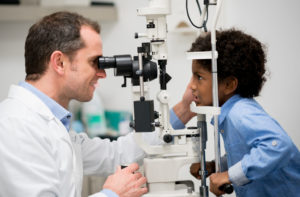July 15, 2022
By Dwight Akerman, OD, MBA, FAAO, FBCLA, FIACLE
 Eye care professionals should strive to deploy a comprehensive myopia management strategy that involves decision making based on age, lifestyle, familial risk, axial length, position on axial length growth charts, progression rate, risk of high myopia, potential side effects, and individual preferences. This personalized approach ensures optimal long-term myopia management and helps reduce the risk of visual impairment and blindness later in life.
Eye care professionals should strive to deploy a comprehensive myopia management strategy that involves decision making based on age, lifestyle, familial risk, axial length, position on axial length growth charts, progression rate, risk of high myopia, potential side effects, and individual preferences. This personalized approach ensures optimal long-term myopia management and helps reduce the risk of visual impairment and blindness later in life.
This retrospective study by Mutti et al. analyzed data from the U.S.-based Collaborative Longitudinal Evaluation of Ethnicity and Refractive Error (CLEERE) Study. It aimed to develop models predicting future refractive error and axial length using children’s baseline data and history of myopia progression and axial elongation.
The researchers analyzed data from 916 myopic children aged 7-14 at study entry. Younger age, a greater degree of myopia, and Asian American ethnicity were significantly associated with faster progression the following year. However, previous progression or elongation, time spent outdoors, and parental myopia were not.
The findings indicate that previous myopic progression is a poor indicator of future progression. Initiation of myopia control should, therefore, not depend on the history of progression. Nearly all young myopes progress, which argues in favor of managing all myopic children, irrespective of their estimated progression rate. Only managing the supposedly fast progressors will ignore many children who could benefit from myopia management.
Abstract
The Limited Value of Prior Change in Predicting Future Progression of Juvenile-onset Myopia
Donald O Mutti, Loraine T Sinnott, Noel A Brennan, Xu Cheng, Karla Zadnik, Collaborative Longitudinal Evaluation of Ethnicity and Refractive Error (CLEERE) Study Group
Significance: Identifying children at the highest risk for rapid myopia progression and/or rapid axial elongation could help prioritize who should receive clinical treatment or be enrolled in randomized clinical trials. Our models suggest that these goals are difficult to accomplish.
Purpose: This study aimed to develop models predicting future refractive error and axial length using children’s baseline data and history of myopia progression and axial elongation.
Methods: Models predicting refractive error and axial length were created using randomly assigned training and test data sets from 916 myopic participants in the Collaborative Longitudinal Evaluation of Ethnicity and Refractive Error Study. Subjects were 7 to 14 years of age at study entry with three consecutive annual visits that included cycloplegic A-scan ultrasound and autorefraction. The effect of adding prior change in axial length and refractive error was evaluated for each model.
Results: Age, ethnicity, and greater myopia were significant predictors of future refractive error and axial length, whereas prior progression or elongation, near work, time outdoors, and parental myopia were not. The 95% limits for the difference between actual and predicted change were ±0.22 D and ±0.14 mm without prior change data compared with ±0.26 D and ±0.16 mm with prior change data. Sensitivity and specificity for identifying fast progressors were between 60.8 and 63.2%, respectively, when the cut points were close to the sample average. Positive predictive value and sample yield were even lower when the cut points were more extreme.
Conclusions: Young, more myopic Asian American children in the Collaborative Longitudinal Evaluation of Ethnicity and Refractive Error Study were the most likely to progress rapidly. Clinical trials should expect average progression rates that reflect sample demographics and may have difficulty recruiting generalizable samples that progress faster than that average. Knowing progression or elongation history does not seem to help the clinical decision regarding initiating myopia control.
Mutti, D. O., Sinnott, L. T., Brennan, N. A., Cheng, X., & Zadnik, K. (2022). The Limited Value of Prior Change in Predicting Future Progression of Juvenile-onset Myopia. Optometry and Vision Science, 99(5), 424-433.
DOI: 10.1097/OPX.0000000000001883













